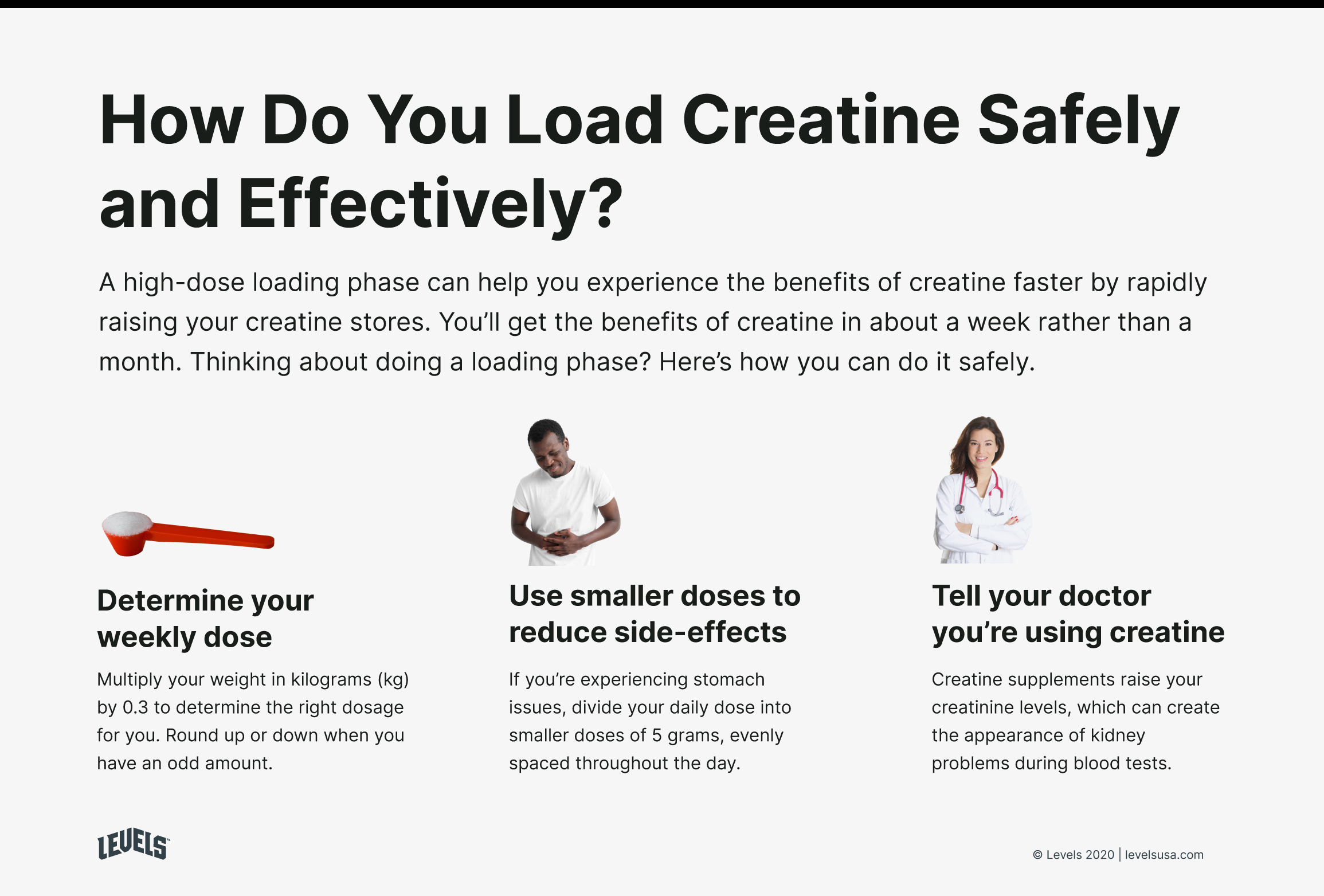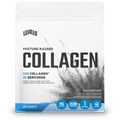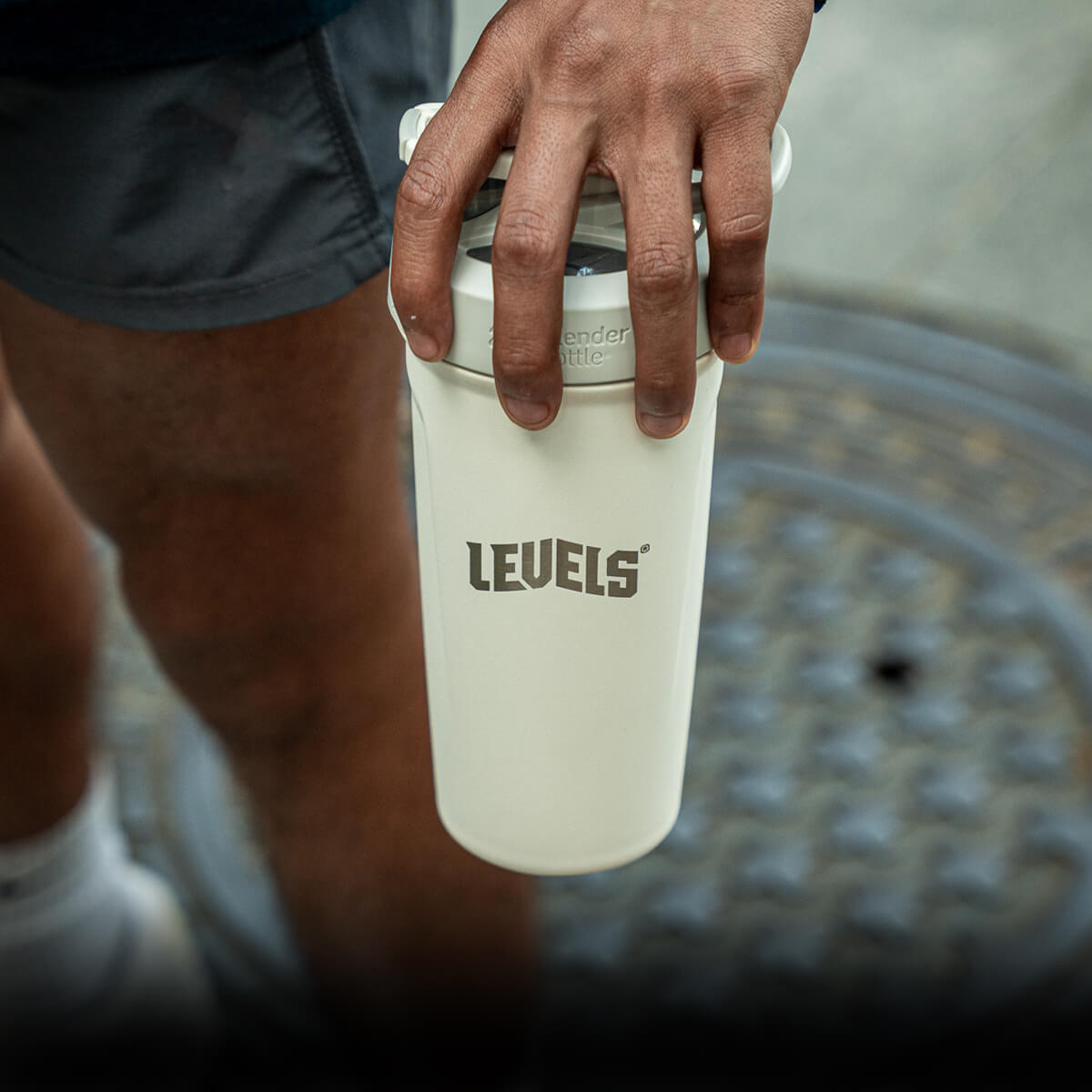Creatine monohydrate is one of the safest and best-studied supplements. It can increase your strength, raise your power output, and help you add lean muscle mass.
And a creatine loading phase helps you get all of the benefits of creatine--only faster.
In this article, you’ll learn what cutting-edge science says about creatine loading, why it works, benefits and drawbacks, and how to do it safely and effectively.
What is a Creatine Loading Phase?
The creatine loading phase refers to the practice of taking a higher dose of creatine each day for about one week.
During creatine loading, people use doses of 20-30 grams per day for 5-7 days to reach maximum muscle saturation levels of creatine[*].
After the loading phase is over, people typically take lower doses of 3-5 grams per day of creatine to maintain elevated creatine levels[*].

Once you load creatine, you can maintain the effects of creatine indefinitely with lower doses. So if you’ve already used a loading phase, you don’t need to load again unless you take a break from supplementing with it.
Is Creatine Loading Necessary?
In a word, no.
Creatine loading is not necessary to achieve the benefits of creatine.
Although a high-dose loading phase allows you to experience the benefits of creatine within a week, research shows that within one month, lower doses of 3-5 grams per day build up equally well in your muscles[*].
In other words, loading is a shortcut. However, if you’re patient, you can still achieve the same benefits with typical creatine doses.
Benefits of Loading Creatine
In a nutshell, loading creatine gives you faster results by rapidly raising your intramuscular creatine stores.
Essentially, you get the usual benefits of creatine--such as higher strength, increased power generation, and a faster rate of muscle-building--in about a week rather than a month[*][*][*].
To understand why loading works, let’s take a look at some simple math.
Typically, your body produces 1 gram of creatine per day from the amino acids arginine, glycine, and methionine[*].
In addition to the body’s natural production, most people obtain an additional gram of creatine each day from eating meat or seafood[*].
And without supplementation, an average, healthy male of 150 pounds has about 120-140 grams of creatine in his muscles naturally[*].
Each day, your body breaks down around 1-2% of your intramuscular stores into the byproduct of creatine, creatinine[*].
Therefore, in theory, without obtaining extra creatine through food or supplements (or going vegetarian, which lowers creatine levels), the creatine levels of the male in the above example will remain in a state of equilibrium[*].
However, by supplementing creatine over the breakdown rate, the same individual could raise his stores by as much as 66% above baseline[*].
In other words, creatine supplements could result in muscle saturation levels of up to 230 grams[*].
And to realize the full benefits of creatine supplements, you must first reach total saturation levels.

Here’s how the math works for time to reach saturation, assuming the individual from our example goes from a “normal” 120 grams to a fully-saturated 230 grams:
- 3 grams per day: 37 days
- 5 grams per day: 22 days
- 10 grams per day: 11 days
- 20 grams per day: 6 days
- 30 grams per day: 4 days
As you can see, loading creatine could get you better results, faster--as much as 33 days faster.
But is loading creatine the right decision for you? Before you commit, keep reading to learn about the potential downsides.
Downsides and Safety of Loading Creatine
Loading creatine requires higher doses, which are more likely to cause minor gastrointestinal side effects such as bloating or an upset stomach[*].
And while side effects from loading creatine can be unpleasant, they are probably harmless[*].
But if you notice any side effects while loading creatine, you can feel free to stop loading and go to 5 grams per day instead. Within a month at most, your muscles will be saturated with creatine, anyway.
Also, not everyone experiences side effects from creatine loading.
Cost is another potential downside of creatine loading, but a minor one.
A kilogram of creatine--a 7-month supply--costs less than a month-long membership at most gyms, which means a loading phase adds less than $4 to your total cost.
Creatine Loading Safety
If you take creatine, make sure to tell your doctor.
Because creatine supplements raise your creatinine levels, they can falsely create the appearance of kidney problems during routine blood tests[*].
Fortunately, high creatinine from taking creatine supplements is harmless. As long as your doctor knows you’re supplementing, he or she shouldn’t be alarmed.
Similarly, some people have raised concerns that creatine could result in dehydration or poor heat tolerance. However, no peer-reviewed study has ever demonstrated such effects.

Not only that, but a Journal of Athletic Training study also found that 20 grams per day of creatine loading for one week did not affect heat tolerance or hydration status in already-dehydrated men[*].
And other research suggests that creatine may even improve hydration levels and reduce the risk of heat-related illness[*].
To sum up, creatine is one of the safest supplements ever discovered.
Researchers have shown that even high doses of 30 grams per day are safe for up to 5 years (and perhaps longer)[*].
How to Calculate Your Loading Dosage
Thanks to the International Society of Sports Nutrition (ISSN), we have a convenient formula to calculate your ideal creatine loading dose[*].
Simply multiply your weight in kilograms (kg) by 0.3 to determine the dose you’ll take for a week.
Also, feel free to round up or down if you come up with an odd amount. Slightly changing the dose won’t affect your results.
Here are some examples:
- 50 kg (110 lb): take 15 grams of creatine per day for a week
- 75 kg (165 lb): take 23 grams of creatine per day for a week
- 100 kg (220 lb): take 30 grams of creatine per day for a week
Or if you prefer, you can also multiply your weight in pounds by 0.136:
- 100 lb: take 14 grams of creatine per day for a week
- 125 lb: take 17 grams of creatine per day for a week
- 150 lb: take 20 grams of creatine per day for a week
- 175 lb: take 24 grams of creatine per day for a week
- 200 lb: take 27 grams of creatine per day for a week
To reduce the risk of minor side-effects (like bloating or upset stomach), divide your total daily dose into smaller doses of about 5 grams, evenly spaced throughout the day[*].
But if you don’t tolerate loading well, remember that 3-10 grams per day of creatine is still a highly effective supplementation strategy[*][*].
Either way, after you finish loading (or if you skip it), we recommend using 5 grams of creatine daily to enhance exercise performance.
However, if you’re a larger-than-average person, or don’t notice benefits with 5 grams per day, you can use 10 grams of creatine daily for maintenance instead.
The Bottom Line
According to the best science, loading creatine is a safe and effective way to get all the benefits of creatine--about four times faster than you would otherwise.
Want to experience results from creatine after just one week rather than a full month? Calculate your loading dosage using the formula from the previous section.
Have you had undesirable side-effects from loading creatine? If so, don’t sweat it--if you take 5 grams a day, you’ll still get all of the positive effects of creatine after about four weeks.
In the end, for fitness or body composition goals, your nutrition plan and exercise regimen make a vastly more significant difference than whether or not you load creatine.














